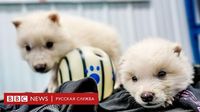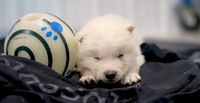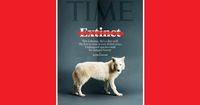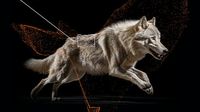In a groundbreaking achievement, the biotechnology company Colossal Biosciences has successfully revived the dire wolf, a prehistoric species that went extinct over 16,000 years ago. This milestone has sparked significant interest and debate within both the scientific community and popular culture, particularly due to the dire wolf's prominent role in the fantasy series "Game of Thrones." On October 1, 2024, Colossal announced the birth of three dire wolf pups, named Romulus, Remus, and Khalisi, marking the first time in history that a species has been brought back from extinction.
The revival process was complex and involved advanced genetic engineering techniques. Colossal's scientists utilized preserved ancient DNA from a 72,000-year-old skull found in Idaho and a 13,000-year-old tooth from Ohio to decipher the genome of the dire wolf (Aenocyon dirus). They made 20 precise edits among 2.5 billion base pairs in the cells of a common gray wolf (Canis lupus) to recreate the genetic traits of the extinct predator. These modifications included changes that influenced the size, musculature, and fur color of the resulting pups, which exhibit characteristics reminiscent of their ancient ancestors.
According to Dr. Beth Shapiro, the chief scientist at Colossal, the team successfully integrated these modified cells into domestic dog eggs, with large hound breeds serving as surrogate mothers. The pups, now residing in a protected area in the United States, are being closely monitored to study the effects of the genetic modifications. As of now, they weigh 20-25% more than typical gray wolf pups of their age, showcasing their enhanced physical traits.
"On October 1, 2024, for the first time in human history, Colossal successfully restored an extinct species," the company stated in a press release. This declaration has generated excitement, with notable figures like Kit Harington, who portrayed Jon Snow in "Game of Thrones," expressing his awe at the revival. Harington commented, "It's truly amazing. To see with my own eyes beautiful animals that for many years I could only imagine. To know that now they are real and have returned."
While the revival of the dire wolf has captured the public's imagination, it has also raised questions about the ethical implications and scientific validity of such endeavors. Critics, including paleontologist Nick Rowlands from the University of Otago, argue that the pups should not be considered true dire wolves. He stated, "Colossal produced a gray wolf with some characteristics of a dire wolf, like a large skull and white fur. This is a hybrid." This skepticism reflects broader concerns within the scientific community regarding the reliability of using ancient DNA for cloning or biological replication.
Despite the excitement surrounding this achievement, some experts caution against labeling the pups as true representatives of the extinct species. Biologist Vincent Lynch from the University of Buffalo remarked, "All we can do now is create something that may superficially resemble something else, rather than fully resurrecting an extinct species." Similarly, Professor Anders Bergström from the University of East Anglia emphasized, "I would say that this animal is not a dire wolf, and to claim that a dire wolf has been revived is inaccurate."
Colossal has faced scrutiny over its marketing strategies and the scientific claims it has made. The company asserts that 99.5% of the pups' genomes match that of the dire wolf, but critics argue that this comparison is misleading. For instance, 99.8% of the chimpanzee genome is similar to that of modern humans, yet no one would consider genetically modified primates to be human. This analogy highlights the challenges of defining species and the complexities of genetic editing.
The debate surrounding the dire wolf revival underscores a philosophical discussion about extinction and its permanence. Rowlands cautioned, "If there is no such thing as extinction, how can we learn from our mistakes?" This sentiment resonates with concerns about environmental degradation and the responsibility humans have to protect species from extinction.
Colossal's announcement has not only reignited interest in the dire wolf but has also prompted discussions about the potential for de-extinction in the future. The company previously introduced genetically modified woolly mice, drawing attention to the possibilities of using genetic editing to combat extinction and preserve endangered species. However, as the scientific community continues to evaluate the implications of such technologies, the path forward remains uncertain.
As Colossal Biosciences continues to monitor the dire wolf pups, the world watches closely, intrigued by the intersection of science, ethics, and the revival of a long-lost species. The journey of Romulus, Remus, and Khalisi will undoubtedly contribute to the ongoing conversation about the role of biotechnology in conservation and the delicate balance between innovation and responsibility.
In conclusion, the revival of the dire wolf by Colossal Biosciences represents a significant milestone in the field of biotechnology. While the achievement has garnered widespread attention and excitement, it also raises critical questions about the nature of species, extinction, and the ethical considerations of manipulating genetics. As scientists continue to explore the possibilities of de-extinction, the case of the dire wolf serves as a poignant reminder of the complexities inherent in such endeavors.










